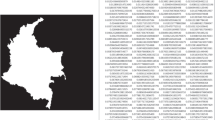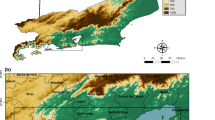Abstract
This research characterizes the spatial and temporal distribution of cloud-to-ground lightning occurring during the winter season (December through February) by utilizing 14 years (2002–2015) of data from the National Lightning Detection Network. Additionally, a Spatial Synoptic Classification system was utilized to examine flash patterns associated with a variety of weather types. The spatial and temporal analysis was conducted by incorporating these datasets into a geographic information system to determine the winter season distribution and associated lightning characteristics across the contiguous US as well as within weather types. The Southeast US and adjacent Oceanic regions, as well as California and Nevada were examined at a higher spatial resolution to further discern flash patterns. The results provide visualization of the lightning flash distribution utilizing flash density and lightning day metrics by weather type and for the winter months; a season under-represented in previous lightning investigations.












Similar content being viewed by others
References
Bentley M, Stallins JA, Ashley WS (2012) Synoptic environments favourable for urban convection in Atlanta, Georgia. Int J Clim 32(8):1287–1294
Brook M, Nakano M, Krehbiel P, Takeuit T (1982) The electrical structure of the Hokuiku winter thunderstorms. J Geophys Res 87:1207–1215
Carlson TN (1991) Mid-latitude weather systems. Penn State University Press, State College
Changnon SA (2003) Characteristics of ice storms in the united states. J Appl Meteorol 42:630–639. https://doi.org/10.1175/1520-0450(2003)042%3c0630:COISIT%3e2.0.CO;2
Cummins KL, Murphy MJ (2009) An overview of lightning locating systems: history, techniques, and data uses, with an in-depth look at the U.S. NLDN. IEEE Trans Electromagn Compat 51(3 PART 1):499–518. https://doi.org/10.1109/temc.2009.2023450
Cummins KL, Cramer JA, Biagi CJ, Krider EP, Jerauld J, Uman MA, Rakov VA (2006) The U.S. national lightning detection network: post-upgrade status. In: Preprints, 86th AMS Annual Meeting, Am Meteorol Soc
Curran JT, Pearson AD (1971) Proximity soundings for thunderstorms with snow. In: Preprints, 7th Conference of Severe Local Storms, Am Meteorol Soc, pp 118–119
Curran EB, Holle RL, Lopez RE (2000) Lightning casualties and damages in the United States from 1959 to 1994. J Clim 13:3448–3464
Engholm CD, Williams ER, Dole RM (1990) Meteorological and electrical conditions associated with positive cloud-to-ground lightning. Mon Weather Rev 118:470–487
Henry WK (1979) Some aspects of the fate of cold fronts in the Gulf of Mexico. Mon Weather Rev 107:1078–1082
Hodanish S, Sharp D, Collins W, Paxton C, Orville RE (1997) A 10-year monthly lightning climatology of Florida: 1986–95. Weather Forecasting 12:439–448
Holle RL (2014) Diurnal variations of NLDN-reported cloud-to-ground lightning in the United States. Mon Weather Rev 142:1037–1052. https://doi.org/10.1175/MWR-D-13-00121.1
Holle RL, Cummins KL (2010) Monthly NLDN distributions of U.S. cloud-to-ground lightning. In: Preprints, Int’l Lightning Meteorology Conference of Vaisala, Inc., April 21–22, Orlando, FL
Holle RL, Watson AI (1996) Lightning during two central U.S. winter precipitation events. Weather Forecasting 11:599–614
Holle RL, López RE, Howard KW, Cummins KL, Malone MD, Krider PE (1997) An isolated winter cloud-to-ground lightning flash causing damage and injury in Connecticut. Bull Amer Meteorol Soc 78:437–441
Holle RL, Cummins KL, Brooks WA (2016) Seasonal, monthly, and weekly distributions of NLDN and GLD360 cloud-to-ground lightning. Mon Weather Rev 144:2855–2870. https://doi.org/10.1175/MWR-D-16-0051.1
Hunter SM, Underwood SJ, Holle RL, Mote TL (2001) Winter lightning and heavy frozen precipitation in the Southeast United States. Weather Forecasting 16:478–490
Kalkstein LS, Nichols MC, Barthel DC, Greene SJ (1996) A new spatial synoptic classification: application to air-mass analysis. Int J Clim 16:983–1004
Koshak WJ, Cummins KL, Buechler DE, Vant-Hull B, Blakeslee RJ, Williams ER, Peterson HS (2015) Variability of CONUS lightning in 2003-12 and associated impacts. J Appl Meteorol Clim 54:15–41. https://doi.org/10.1175/JAMC-D-14-0072.1
Kristovich D et al (2016) The Ontario Winter Lake-effect Systems (OWLeS) field campaign: Scientific and educational adventures to further our knowledge and prediction of lake-effect storms. Bull Am Meteorol Soc 98:315–332
Latham D, Williams E (2001) Lightning and forest fires. Chapter 11, Forest fires: behavior and ecological effects. Academic Press, Cambridge, pp 375–418
Market PS, Halcomb CE, Ebert RL (2002) A climatology of thundersnow events over the contiguous United States. Weather Forecasting 17:1290–1295
Medici G, Cummins KL, Cecil DJ, Koshak WJ, Rudlosky SD (2017) The intracloud lightning fraction in the contiguous United States. Mon Weather Rev 145:4481–4499
Michimoto K (1993) A study of radar echoes and their relation to lightning discharges of thunderclouds in the Hokuriku district PART II: observation and analysis of “single-flash” thunderclouds in midwinter. J Meteorol Soc Japan 71:195–204
Montanyà J, Fabró F, Van Der Velde O, March V, Rolfe Williams E, Pineda N, Romero DS, Freijo M (2016) Global distribution of winter lightning: a threat to wind turbines and aircraft. Nat Haz Earth Sys Sci 16:1465–1472. https://doi.org/10.5194/nhess-16-1465-2016
Murphy M, Nag A (2015) Cloud lightning performance and climatology of the U.S. based on the upgraded U.S. National Lightning Detection Network. In: Preprints, Seventh Conference on the Meteorological Applications of Lightning Data, Am Meteoril Soc, Phoenix, AZ
Nag A, Murphy MJ, Schulz W, Cummins KL (2015) Lightning locating systems: insights on characteristics and validation techniques. Earth Space Sci. https://doi.org/10.1002/2014EA000051
Orville RE (1991) Lightning ground flash density in the contiguous United States—1989. Mon Weather Rev 119:573–577
Orville RE, Huffines GR (2001) Cloud-to-Ground Lightning in the United States: NLDN Results in the First Decade, 1989–98. Mon Weather Rev 129:1179–1193
Orville RE, Silver AC (1997) Lightning ground flash density in the contiguous United States: 1992–95. Mon Weather Rev 125:631–638
Orville RE, Huffines GR, Burrows WR, Cummins KL (2011) The North American lightning detection network (NALDN) analysis of flash data: 2001–09. Mon Weather Rev 139:1305–1322. https://doi.org/10.1175/2010MWR3452.1
Pettegrew BP, Market PS, Wolf RA, Holle RL, Demetriades NWS (2009) A case study of severe winter convection in the Midwest. Weather Forecasting 24:121–139. https://doi.org/10.1175/2008WAF2007103.1
Rakov VA (2003) A review of positive and bipolar lightning discharges. Bull Am Meteorol Soc 84:767–776
Rudlosky SD, Fuelberg HE (2010) Pre- and post-upgrade distributions of NLDN reported cloud-to-ground lightning characteristics in the contiguous United States. Mon Weather Rev 138:3623–3633. https://doi.org/10.1175/2010MWR3283.1
Schultz DM (1999) Lake-effect snowstorms in northern Utah and western New York with and without lightning. Weather Forecasting 14:1023–1031
Sheridan SC (2002) The redevelopment of a weather-type classification scheme for North America. Int J Clim 22:51–68. https://doi.org/10.1002/joc.709
Stallins JA, Bentley ML, Rose LS (2006) Cloud-to-ground flash patterns for Atlanta, Georgia (USA) from 1992 to 2003. Clim Res 30:99–112
Stallins JA, Carpenter J, Bentley ML, Ashley WS, Mulholland JA (2013) Weekend-weekday aerosols and geographic variability in cloud-to-ground lightning for the urban region of Atlanta, Georgia, USA. Reg Env Change 13(1):137–151
Steiger SM, Hamilton R, Keeler J, Orville RE (2009) Lake-effect thunderstorms in the lower Great Lakes. J Appl Meteorol Clim 48:889–902
Trapp RJ, Schultz DM, Ryzhkov AV, Holle RL (2001) Multiscale structure and evolution of an Oklahoma winter precipitation event. Mon Weather Rev 129:486–501
Virts KS, Wallace JM, Hutchins ML, Holzworth RH (2015) Diurnal and seasonal lightning variability over the gulf stream and the Gulf of Mexico. J Atmos Sci 72:2657–2665. https://doi.org/10.1175/JAS-D-14-0233.1
Yokoyama S, Honjo N, Yasuda Y, Yamamoto K (2014) Causes of wind turbine blade damages due to lightning and future research target to get better protection measures. In: Preprints, 2014 International Conference on Lightning Protection, pp 823–830. https://doi.org/10.1109/iclp.2014.6973237
Zajac BA, Rutledge SA (2001) Cloud-to-ground lightning activity in the contiguous United States from 1995 to 1999. Mon Weather Rev 129:999–1019
Acknowledgements
The authors wish to thank the anonymous reviewers for their constructive and detailed comments that greatly strengthened this manuscript.
Author information
Authors and Affiliations
Corresponding author
Additional information
Responsible Editor: C. Simmer.
Rights and permissions
About this article
Cite this article
Bentley, M.L., Riley, C. & Mazur, E. A winter-season lightning climatology for the contiguous United States. Meteorol Atmos Phys 131, 1327–1340 (2019). https://doi.org/10.1007/s00703-018-0641-2
Received:
Accepted:
Published:
Issue Date:
DOI: https://doi.org/10.1007/s00703-018-0641-2




